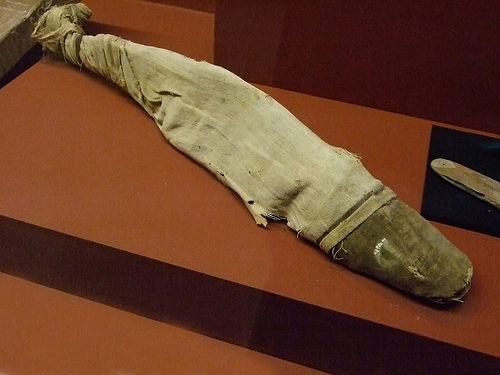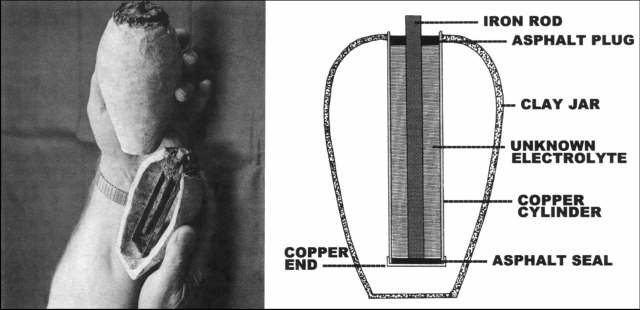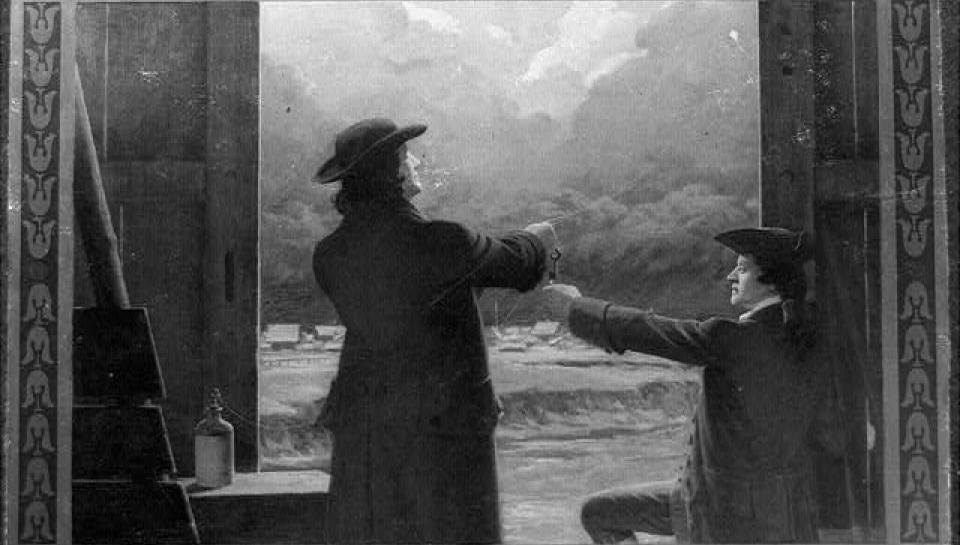We couldn’t imagine a world today without electricity, so to who do we owe the honor of inventing this marvel? First of all, as a form of energy, electricity cannot be invented. As for who discovered it, like most inquiries in fundamental research, electricity has been studied by a number of scientists across the centuries.
Some believe Ben Franklin was the first to discover electricity, but, as we’ll learn later in this article, his famous experiment involving a kite and a key actually showed that lightning is a form of electricity. Electricity as a physical phenomenon had been identified thousands of years before Franklin.
What is electricity in the first place?
Electricity simply refers to the movement of electrons through a conducting material, such as a copper wire.
The force applied to electrons to push them through the conducting wire is known as voltage, and the rate of flow of the electrons is known as current.
If you imagine the conducting wire as a pipe through which water can flow, voltage is the pressure applied to make the water flow while current is how much water is flowing through the pipe every second.
In metals, electrons are free to move, which makes them great conductors of electricity. Some materials, however, do not conduct electricity — these are insulators. However, there are instances when an insulator can carry an electrical charge. If you rub two different insulating materials together, such as a balloon and a jumper, electrons will transfer from the jumper to the balloon, which gets loaded with a negative charge. This build-up of electrons on an insulator is known as static electricity — if you touch the charged balloon, you can feel these physics in action with a mild shock.
The Ancient Greeks and the Birth of Electricity
To the best of our knowledge, the Greeks were the first to discover the notion of electrical charge over 2,600 years ago. Around 600 BCE, the Greek philosopher Thales of Miletus observed that rubbing certain materials together, such as amber and fur, would cause them to attract nearby objects. This phenomenon, known as static electricity, would lay the foundation for centuries of electrical research.
We also know from ancient texts that Egyptians knew that some species of electric fish could trigger shocks in the body. In fact, the ancient Egyptians likely used the electric Nile Catfish to treat headaches and nerve pain — a practice known as ichthyoelectroanalgesia that remained in medical use until the late 1600s.

Electricity in the ancient world: the story of the Baghdad ‘battery’
But, without a doubt, the most amazing example of electricity in antiquity is the Baghdad battery. This peculiar instrument was discovered by an expedition led by Dr. Wilhelm Koenig of the Iraq Museum in Baghdad in 1936. The finding consisted of a vase made of clay, about 14 centimeters tall and with the largest diameter measuring 8 centimeters.
Dating suggests that the artifact is about 2,000 years old, from the 1st century AD, during a time when the region was occupied by the Parthian Empire.
Although its appearance didn’t seem out of the ordinary, scientists quickly learned that there was much more to the small clay pot once they peeked inside.
The vase contains a hollow cylinder made of a sheet of copper of high purity. The lower end of the cylinder was covered with a piece of sheet copper while the inner bottom of the cylinder was covered with a layer of asphalt, only 3 millimeters thick. The upper end of the cylinder was plugged by a heavy and thick layer of asphalt. The center of the plug featured a solid piece of iron.

At the time of the discovery, Koening recognized that the jar and its odd metal structure were in a configuration that suggested it could have functioned as a wet-cell battery. In fact, it seems to have served no other purpose than that of generating a weak electric current.
Experiments conducted with replicas of the jar employing various acids found that a mixture of acetic acid (distilled vinegar) and grapefruit juice generated 0.5 volts for several days.
More such artifacts have been discovered over the years around sites in modern-day Iraq, which were made by Parthians and Sassanids. However, what purpose could these ancient batteries have served considering that no motors, lights, or any similar electric device have been found?
One possible application of the Baghdad battery is for medical therapy, as the Greeks and Romans of the time routinely employed the common electric ray to deliver electric shocks to patients for treating pain, as outlined earlier.
But the lack of any apparent use for electrical current has led some to question whether these ancient jars were actually used as batteries. Some believe these jars could have been used to store important documents in order to keep the moisture from damaging the papyrus rather than being some electrical device.
What’s more, since there is no record that the Parthians, nor anyone in the ancient world for that matter, possessed a formal theory of electricity, the discovery of the battery was likely an accident.
Fast forward to 1,600 years into the future. During this time, an English physicist by the name of Wiliam Gilbert published a treaty on the attractive nature of amber and used the Latin word electricus to describe it. Not too long after, another Englishman named Thomas Browned publishes a book on physics in which he uses the word “electricity” to describe Gilbert’s work.
Ben Franklin and his lightning-kite experiment

Many have been taught in elementary school that Benjamin Franklin, Founding Father and renowned inventor, discovered electricity by tying a key to a kite while standing in a thunderstorm. However, this is not true at all. Franklin wasn’t the first scientist to study charged particles nor did he ever set out to discover electricity — his investigations merely sought to demonstrate that lightning was a form of static electricity.
During the mid-18th century, well before he embarked on his famous experiment, Franklin was toying with electricity tubes that were given to him by his friend Peter Collinson. It is following these experiences that Franklin hypothesized that lighting was a ‘massive electric spark’ and proposed an experiment with an elevated rod to “draw down the electric fire” from the cloud. Well aware of the dangers involved, Franklin also mentioned in one of his letters to Collinson that any people involved in such an experiment would have to observe the phenomenon in the protection of an enclosure similar to a soldier’s sentry box.
Word of Franklin’s theories reached Europe where Frenchman Thomas Francois D’Alimbard used a 50-foot-long vertical rod to attract the “electric fluid” (lightning). He was successful on May 10, 1752 in Paris. In July, an Englishman, John Canton, successfully replicated the experiment. Later, Russian chemist Mikhail Lomonosov also reached the same conclusion after his own experiment.
Franklin, apparently unaware of these developments across the pond, undertook his own version of the experiment during a thunderstorm on June 1752, in Philadelphia. He stood outside under a shelter while he held on to a silk kite with a key tied to it. When lightning struck, the electricity traveled down the key and its charge was collected in a Leyden jar — an antique electrical component which stores a high-voltage electric charge and can release it at a later date.
Many believe that the kite actually gathered electric charge from the atmosphere and wasn’t directly hit by lightning — otherwise, Franklin could have been toast that fateful day.
Franklin himself later wrote in the Pennsylvania Gazette on October 19, 1752, detailing his findings and offering instructions on how to recreate the experiment:
” s soon as any of the Thunder Clouds come over the Kite, the pointed Wire will draw the Electric Fire from them, and the Kite, with all the Twine, will be electrified, and the loose Filaments of the Twine will stand out every Way, and be attracted by an approaching Finger. And when the Rain has wet the Kite and Twine, so that it can conduct the Electric Fire freely, you will find it stream out plentifully from the Key on the Approach of your Knuckle. At this Key the Phial may be charg’d; and from Electric Fire thus obtain’d, Spirits may be kindled, and all the other Electric Experiments be perform’d, which are usually done by the Help of a rubbed Glass Globe or Tube; and thereby the Sameness of the Electric Matter with that of Lightning compleatly demonstrated.”
That being said, Franklin didn’t discover electricity. He wasn’t even the first to actually perform an experiment showing that lighting is electricity and write about the findings. However, he is credited as the first scientist to draw up the hypothesis and the experimental conditions.
The first practical uses of electricity and the rise of industry
After the revelations of Franklin’s experiments, science boomed across all fields, including electromagnetism.
In 1800, an Italian doctor named Luigi Galvani found that when a frog touched two different kinds of metals, its leg twitched. Based on these findings, his peer Alessandro Volta concluded that a kind of electrical potential exists between the two metal plates, causing an electrical charge to flow through the frog’s leg.
Volta used this insight to invent the first modern batteries. In his honor, we now name one of the properties of electricity, electrical potential (or voltage), after him.
In 1808, Humphry Davy is credited with the invention of the first effective “arc lamp”, a piece of carbon that generated light when connected to a battery. Davy essentially invented the first light bulb.
In 1820, Hans Christian Oersted, A.M. Ampère, and D.F.G. Arago confirmed the relationship between electricity and magnetism. Ampère, a French mathematician and physicist, is considered the father of electrodynamics. The base unit of electric current in the International System of Units (SI), the “ampere” or “amp”, is named after him. Later, in 1826, Georg Ohm defined the relationship between power, voltage, current, and resistance in “Ohm’s Law”. The basic unit for resistance, the ohm, carries his name.
In 1831, Michael Faraday invented the electric dynamo — essentially a crude power generator — that used a magnet that moved inside a coil of copper wire, creating a tiny electric current.
This set the stage for an electrical revolution across the world. In 1878, American inventor Thomas Edison unveiled the first practical incandescent light bulb that could generate light for hours on end. Edison is also credited with developing a system for distributing electricity to homes and businesses. His work would revolutionize the way we live and work, and cement his place in history as one of the greatest inventors of all time.

Later, in the late 1800s, Serbian-American inventor Nikola Tesla pioneered work with alternating current, the induction motor, and the polyphase distribution system. Tesla also had competing patents with Marconi for the invention of the radio.
Electricity today and in the future
Electricity has come a long way since the days of Thales and Franklin. The moment humankind harnessed electricity was a milestone in history. The world would have never been the same and most of the inventions we take for granted today would simply not have been possible without electricity.

Today, electricity powers the world. We may not think twice before flipping a switch or charging our phones, but it is important to take time to appreciate the journey of the science that makes our modern life so comfortable. At the same time, all the amazing progress and prosperity that is enabled by electricity has had a hidden cost.
Even to this day, most of our electricity comes from burning fossil fuels such as coal in huge power generators. Only a fraction of the world’s energy needs are met by renewable energy such as solar or wind. This needs to change if we’re to avert a global catastrophe at the hands of anthropogenic global warming.
Bottom line: electricity wasn’t discovered by just one person. The concept of electricity was known to people for thousands of years. When it was finally time to form a theory of electricity and develop it commercially, many great minds worked on the problem at the same time.


